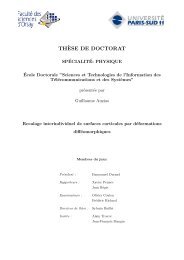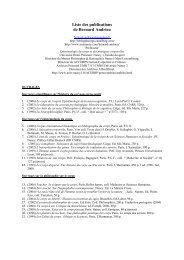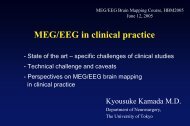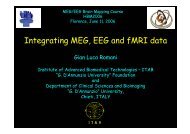Hippocampal Sclerosis in Temporal Lobe Epilepsy: Findings at 7 T 1
Hippocampal Sclerosis in Temporal Lobe Epilepsy: Findings at 7 T 1
Hippocampal Sclerosis in Temporal Lobe Epilepsy: Findings at 7 T 1
You also want an ePaper? Increase the reach of your titles
YUMPU automatically turns print PDFs into web optimized ePapers that Google loves.
NEURORADIOLOGY: <strong>Hippocampal</strong> <strong>Sclerosis</strong> <strong>in</strong> <strong>Temporal</strong> <strong>Lobe</strong> <strong>Epilepsy</strong>Henry et al26 years. The mean age of the rema<strong>in</strong><strong>in</strong>geight p<strong>at</strong>ients with TLE was 28 years.The cl<strong>in</strong>ical characteristics of the p<strong>at</strong>ientsare summarized <strong>in</strong> Table 1 .Qualit<strong>at</strong>ive Visual AssessmentIn control subjects, the <strong>in</strong>ternal structurewas visible <strong>in</strong> all sections of the head,body, and tail of the hippocampus ( Fig 3 ).In each p<strong>at</strong>ient ( Table 2 ), the abnormalhippocampus had <strong>at</strong> least one ofthe follow<strong>in</strong>g signs: <strong>at</strong>rophy ( n = 7), T2-weighted hyper<strong>in</strong>tense signal ( n = 6),and fl<strong>at</strong>ten<strong>in</strong>g of the head ( n = 6). Ineach subject, hippocampal stri<strong>at</strong>ion andadditional detailed an<strong>at</strong>omic fe<strong>at</strong>ureswere clearly apparent. In each controlsubject, it was possible to del<strong>in</strong>e<strong>at</strong>e cont<strong>in</strong>uoushippocampal stri<strong>at</strong>ion. This whitem<strong>at</strong>ter band appeared to be less dist<strong>in</strong>guishedfrom surround<strong>in</strong>g gray m<strong>at</strong>ter<strong>in</strong> all sclerotic hippocampi. Thus, the partialloss of hippocampal stri<strong>at</strong>ion wasobserved <strong>in</strong> the hippocampus on the sideof ictal onset <strong>in</strong> all but two p<strong>at</strong>ients(p<strong>at</strong>ients 1 and 7) and <strong>in</strong> none of thecontrol subjects. Def<strong>in</strong>ite hippocampalmalrot<strong>at</strong>ions were observed <strong>in</strong> three p<strong>at</strong>ients;they were seen twice <strong>in</strong> p<strong>at</strong>ientswith ipsil<strong>at</strong>eral onset and once <strong>in</strong> a p<strong>at</strong>ientwith contral<strong>at</strong>eral to ictal onset( Fig 4 ). Malrot<strong>at</strong>ions were observed <strong>in</strong>four control subjects: They were observedbil<strong>at</strong>erally <strong>in</strong> subject 1 and on theleft side <strong>in</strong> subjects 6, 10, and 11. Thedeterm<strong>in</strong><strong>at</strong>ion of malrot<strong>at</strong>ion showed novari<strong>at</strong>ion between the first and secondobserv<strong>at</strong>ions <strong>in</strong> 18 of 19 subjects; however,one healthy control subject (subject4) was r<strong>at</strong>ed as hav<strong>in</strong>g bil<strong>at</strong>eralhippocampal malrot<strong>at</strong>ion <strong>at</strong> the secondview<strong>in</strong>g but not <strong>at</strong> the first. R<strong>at</strong><strong>in</strong>gsof hippocampal size, signal, shape, andstri<strong>at</strong>ion did not vary between the firstand second view<strong>in</strong>gs.Each p<strong>at</strong>ient had either no or onehippocampal digit<strong>at</strong>ion on the side ofictal onset ( Table 2 ). Three p<strong>at</strong>ients alsohad either no or one contral<strong>at</strong>eral hippocampaldigit<strong>at</strong>ion. Several p<strong>at</strong>ientshad def<strong>in</strong>ite hippocampal <strong>at</strong>rophy. Interest<strong>in</strong>gly,one p<strong>at</strong>ient (p<strong>at</strong>ient 1) hadbil<strong>at</strong>eral nondigit<strong>at</strong>ed hippocampalheads but only mild hippocampal <strong>at</strong>rophyon the epileptogenic side and contral<strong>at</strong>eralnormal hippocampal volumeFigure 2Figure 2: Manual segment<strong>at</strong>ion of two subregions of body of hippocampus on T2-weighted 7-T MRimages <strong>in</strong> subject 2 (24-year-old man). (a, b) Most posterior coronal section <strong>in</strong> (a) head and (b) bodyof hippocampus, as the image on the left of these pairs. Red cross marks the same po<strong>in</strong>t on the pairedcoronal and sagittal images, and on sagittal section (as the image on the right of these pairs) <strong>in</strong>dic<strong>at</strong>es levelof coronal section (front is on left side of sagittal image). (c) Limits of CA1–CA3 (dark blue) and CA4 anddent<strong>at</strong>e gyrus (light blue) regions on coronal section <strong>in</strong> middle of body (with no colored subregions on leftimage and colored subregions on middle image, both show<strong>in</strong>g the same image plane), as <strong>in</strong>dic<strong>at</strong>ed on thesagittal section (right image). (d) Three-dimensional render<strong>in</strong>g of two subregions <strong>in</strong> body of hippocampus,displayed separ<strong>at</strong>ely (left, with CA1–CA3 <strong>in</strong> dark blue, and middle, with CA4 and dent<strong>at</strong>e gyrus <strong>in</strong> light blue)and together (right).( Fig 4, A ). All healthy subjects had twoor three bil<strong>at</strong>eral digit<strong>at</strong>ions of the hippocampalhead; however, one of these22 hippocampal heads had one digit<strong>at</strong>ion,consistent with reports of postmortemstud ies <strong>in</strong> cadavers withoutRadiology: Volume 261: Number 1—October 2011 n radiology.rsna.org 203






